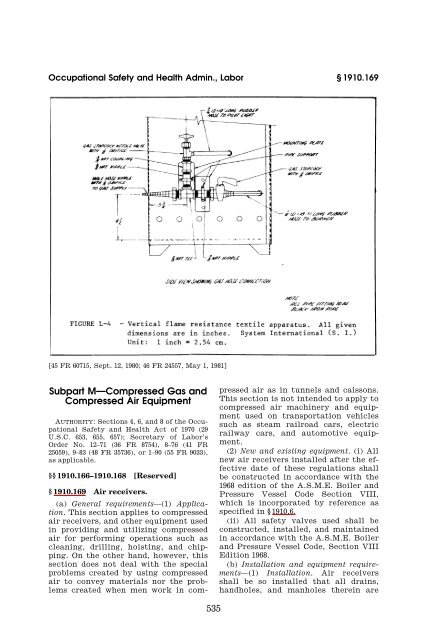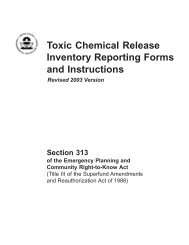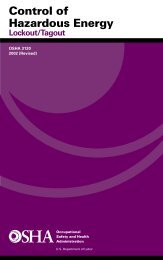1910.169 - Seton Resource Center
1910.169 - Seton Resource Center
1910.169 - Seton Resource Center
Create successful ePaper yourself
Turn your PDF publications into a flip-book with our unique Google optimized e-Paper software.
http://www.smartpdf.info<br />
Occupational Safety and Health Admin., Labor § <strong>1910.169</strong><br />
[45 FR 60715, Sept. 12, 1980; 46 FR 24557, May 1, 1981]<br />
Subpart M—Compressed Gas and<br />
Compressed Air Equipment<br />
AUTHORITY: Sections 4, 6, and 8 of the Occupational<br />
Safety and Health Act of 1970 (29<br />
U.S.C. 653, 655, 657); Secretary of Labor’s<br />
Order No. 12–71 (36 FR 8754), 8–76 (41 FR<br />
25059), 9–83 (48 FR 35736), or 1–90 (55 FR 9033),<br />
as applicable.<br />
§§ 1910.166–1910.168 [Reserved]<br />
§ <strong>1910.169</strong> Air receivers.<br />
(a) General requirements—(1) Application.<br />
This section applies to compressed<br />
air receivers, and other equipment used<br />
in providing and utilizing compressed<br />
air for performing operations such as<br />
cleaning, drilling, hoisting, and chipping.<br />
On the other hand, however, this<br />
section does not deal with the special<br />
problems created by using compressed<br />
air to convey materials nor the problems<br />
created when men work in compressed<br />
air as in tunnels and caissons.<br />
This section is not intended to apply to<br />
compressed air machinery and equipment<br />
used on transportation vehicles<br />
such as steam railroad cars, electric<br />
railway cars, and automotive equipment.<br />
(2) New and existing equipment. (i) All<br />
new air receivers installed after the effective<br />
date of these regulations shall<br />
be constructed in accordance with the<br />
1968 edition of the A.S.M.E. Boiler and<br />
Pressure Vessel Code Section VIII,<br />
which is incorporated by reference as<br />
specified in § 1910.6.<br />
(ii) All safety valves used shall be<br />
constructed, installed, and maintained<br />
in accordance with the A.S.M.E. Boiler<br />
and Pressure Vessel Code, Section VIII<br />
Edition 1968.<br />
(b) Installation and equipment requirements—(1)<br />
Installation. Air receivers<br />
shall be so installed that all drains,<br />
handholes, and manholes therein are<br />
535<br />
http://www.smartpdf.info
http://www.smartpdf.info<br />
§ 1910.176<br />
easily accessible. Under no circumstances<br />
shall an air receiver be<br />
buried underground or located in an inaccessible<br />
place.<br />
(2) Drains and traps. A drain pipe and<br />
valve shall be installed at the lowest<br />
point of every air receiver to provide<br />
for the removal of accumulated oil and<br />
water. Adequate automatic traps may<br />
be installed in addition to drain valves.<br />
The drain valve on the air receiver<br />
shall be opened and the receiver completely<br />
drained frequently and at such<br />
intervals as to prevent the accumulation<br />
of excessive amounts of liquid in<br />
the receiver.<br />
(3) Gages and valves. (i) Every air receiver<br />
shall be equipped with an indicating<br />
pressure gage (so located as to<br />
be readily visible) and with one or<br />
more spring-loaded safety valves. The<br />
total relieving capacity of such safety<br />
valves shall be such as to prevent pressure<br />
in the receiver from exceeding the<br />
maximum allowable working pressure<br />
of the receiver by more than 10 percent.<br />
(ii) No valve of any type shall be<br />
placed between the air receiver and its<br />
safety valve or valves.<br />
(iii) Safety appliances, such as safety<br />
valves, indicating devices and controlling<br />
devices, shall be constructed, located,<br />
and installed so that they cannot<br />
be readily rendered inoperative by<br />
any means, including the elements.<br />
(iv) All safety valves shall be tested<br />
frequently and at regular intervals to<br />
determine whether they are in good operating<br />
condition.<br />
[39 FR 23502, June 27, 1974, as amended at 49<br />
FR 5322, Feb. 10, 1984; 61 FR 9239, Mar. 7, 1996]<br />
Subpart N—Materials Handling<br />
and Storage<br />
29 CFR Ch. XVII (7–1–11 Edition)<br />
AUTHORITY: Secs. 4, 6, and 8 of the Occupational<br />
Safety and Health Act of 1970 (29<br />
U.S.C. 653, 655, 657); Secretary of Labor’s<br />
Order No. 12–71 (36 FR 8754), 8–76 (41 FR<br />
25059), 9–83 (48 FR 35736), 1–90 (55 FR 9033), 6–<br />
96 (62 FR 111), 3–2000 (65 FR 50017), or 5–2002<br />
(67 FR 65008) as applicable; and 29 CFR part<br />
1911.<br />
Sections 1910.176, 1910.177, 1910.178, 1910.179,<br />
1910.180, 1910.181, and 1910.184 also issued<br />
under 29 CFR part 1911.<br />
EFFECTIVE DATE NOTE: At 76 FR 24698, May<br />
2, 2011, the authority citation was revised, effective<br />
Aug. 1, 2011. For the convenience of<br />
the user, the revised text is set forth as follows:<br />
AUTHORITY: Secs. 4, 6, and 8 of the Occupational<br />
Safety and Health Act of 1970 (29<br />
U.S.C. 653, 655, 657); Secretary of Labor’s<br />
Order No. 12–71 (36 FR 8754), 8–76 (41 FR<br />
25059), 9–83 (48 FR 35736), 1–90 (55 FR 9033), 6–<br />
96 (62 FR 111), 3–2000 (65 FR 50017), 5–2002 (67<br />
FR 65008), 5–2007 (72 FR 31159), or 4–2010 (75<br />
FR 55355) as applicable.<br />
Section 1910.177, also issued under 29 CFR<br />
part 1911.<br />
§ 1910.176 Handling materials—general.<br />
(a) Use of mechanical equipment.<br />
Where mechanical handling equipment<br />
is used, sufficient safe clearances shall<br />
be allowed for aisles, at loading docks,<br />
through doorways and wherever turns<br />
or passage must be made. Aisles and<br />
passageways shall be kept clear and in<br />
good repair, with no obstruction across<br />
or in aisles that could create a hazard.<br />
Permanent aisles and passageways<br />
shall be appropriately marked.<br />
(b) Secure storage. Storage of material<br />
shall not create a hazard. Bags, containers,<br />
bundles, etc., stored in tiers<br />
shall be stacked, blocked, interlocked<br />
and limited in height so that they are<br />
stable and secure against sliding or collapse.<br />
(c) Housekeeping. Storage areas shall<br />
be kept free from accumulation of materials<br />
that constitute hazards from<br />
tripping, fire, explosion, or pest harborage.<br />
Vegetation control will be exercised<br />
when necessary.<br />
(d) [Reserved]<br />
(e) Clearance limits. Clearance signs to<br />
warn of clearance limits shall be provided.<br />
(f) Rolling railroad cars. Derail and/or<br />
bumper blocks shall be provided on<br />
spur railroad tracks where a rolling car<br />
could contact other cars being worked,<br />
enter a building, work or traffic area.<br />
(g) Guarding. Covers and/or guardrails<br />
shall be provided to protect personnel<br />
from the hazards of open pits, tanks,<br />
vats, ditches, etc.<br />
[39 FR 23052, June 27, 1974, as amended at 43<br />
FR 49749, Oct. 24, 1978]<br />
§ 1910.177 Servicing multi-piece and<br />
single piece rim wheels.<br />
(a) Scope. (1) This section applies to<br />
the servicing of multi-piece and single<br />
536<br />
http://www.smartpdf.info
















